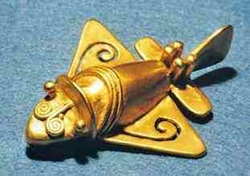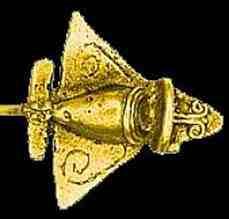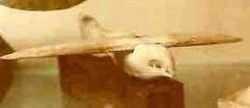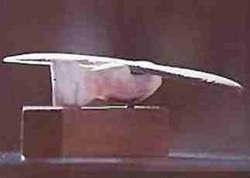A.B.C. of FREEDOM
A.B.C. PART1 A.B.C. PART 2:I A.B.C. PART 2:II HOME REVIEWS&ARTICLES
Ten Mysterious Historical Artifacts
by Simon Cowel
Misinterpretation, Hoax, or just plain unbelievable?.............you decide!
*Artifact -an object formed by humans, particularly one of interest to archaeologists
1 – Ancient Flying Machines
Case 1 – Gold Peruvian Models
1 – Ancient Flying Machines
Case 1 – Gold Peruvian Models
These objects shown in the photographs above have caused considerable controversy.
Some believe that they are nothing more than highly ornate, stylised sculptures of flying insects, others believe that the objects are depictions of flying aircraft.
Why the controversy?
These artefacts, two inches long, made from gold, found in Peru Classified as “Sinu” a pre-Inca culture, are estimated to be 800 – 1000 years old!
The controversy was so great that in 1997, a prototype of the exact (scaled-up) shape of the object was re-created, a propeller and engine added, and it was proved to be an effective flying machine.
Some believe that they are nothing more than highly ornate, stylised sculptures of flying insects, others believe that the objects are depictions of flying aircraft.
Why the controversy?
These artefacts, two inches long, made from gold, found in Peru Classified as “Sinu” a pre-Inca culture, are estimated to be 800 – 1000 years old!
The controversy was so great that in 1997, a prototype of the exact (scaled-up) shape of the object was re-created, a propeller and engine added, and it was proved to be an effective flying machine.
Case 2 - 200BC Egyptian Model
This item, discovered in 1898 in a tomb at Saqquara, Egypt on first glance, appears to be simply a model of a bird –
However, this particular model differs from all other examples of models of the time in that it has no legs or feathers – and its specific aeronautical design features have made historians take special interest in the item.
However, this particular model differs from all other examples of models of the time in that it has no legs or feathers – and its specific aeronautical design features have made historians take special interest in the item.
Dr Messiha, who studies artefacts of this nature, recovered the item from the Cairo museum basement and exhibited it controversially as a “model aeroplane” – claiming that the model has the exact proportions of a “push glider”. The wings are tipped downwards – known today as a “reversedihedral” wing design (used by Concorde) which gives maximum lift without detracting from speed
The Egyptian desire to fly is no secret as there are several ancient papyrus scolls which bear the phrase “I want to fly”. Interestingly, hieroglyphs found on the model translate to “The Gift of Amon” – Amon was known as the Egyptian God of wind and air.
The Egyptian desire to fly is no secret as there are several ancient papyrus scolls which bear the phrase “I want to fly”. Interestingly, hieroglyphs found on the model translate to “The Gift of Amon” – Amon was known as the Egyptian God of wind and air.
Case 3 Ancient Indian "Vimanas."
Known to Historians, but rarely sighted, are a set of ancient books – commissioned by Buddhist Indian Emperor Ashoka the Great (the Beloved of the Gods 304–232 BC) written and read by his secret society called “nine unknown men” – formed to develop and preserve knowledge that may be dangerous to humanity if it fell into the wrong hands
The nine books that were entrusted to the nine unknown men are said to contain information on
The nine books that were entrusted to the nine unknown men are said to contain information on
- Propaganda and psychological warfare
- Physiology (including “the touch of death”)
- Microbiology
- Alchemy
- Communication
- Gravity (and anti gravity devices) – Including technical details of three types of vimanas – ancient flying machines.
- Cosmology (including hyperspace and time travel)
- Light (and details of how to change the speed of light)
- Sociology (including predictions of the fall and rise of empires.





